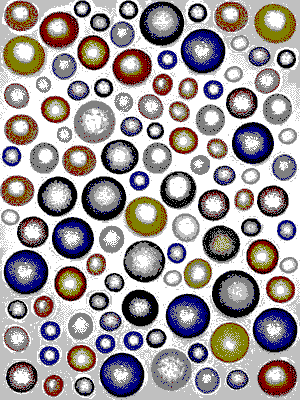View current page
...more recent posts
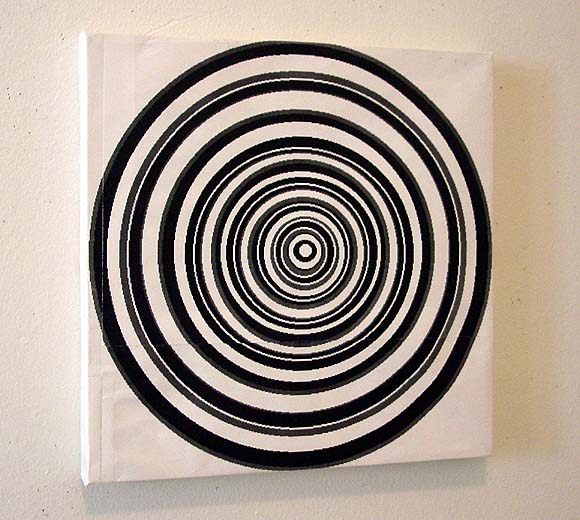
Disc, 1999, ink, paper, linen tape, wood, 10" x 10"
Truth in advertising: what the back of a similar piece looks like.
"72%" Iraqi Turnout Figure Already Plunging
Reuters:
BAGHDAD, Jan 30 (Reuters) - Iraq's Electoral Commission backtracked on earlier estimates of voter turnout in the election, saying a previous figure of 72 percent "was just an estimate" and indicated the actual figure was lower.Whatever the final number ends up being, you can be sure the Bush Media will keep saying 72% ("More than in the US election! Incredible! Aren't we great?"). More words from wet blanket Juan Cole:
At a news conference, commission spokesman Farid Ayar called the 72 percent figure a "guess" and said maybe up to 8 million Iraqis voted, which would be a little over 60 percent of registered voters.
"Percentages and numbers come only after counting and will be announced when it's over ... It's too soon to say that those were the official numbers," he said. "The numbers are only guessing."
The Iraqis did not know the names of the candidates for whom they were supposedly voting. What kind of an election is anonymous! There were even some angry politicians late last week who found out they had been included on lists without their permission. (This is the part of the process that I called a "joke," and I stand by that.)ABC is reporting 44 people killed on election day. Bush, Rice, Rumsfeld, Cheney: great work. You can also count that they'll say the "high" turnout was an after-the-fact justification for the invasion, now that the other justifications have evaporated.
This thing was more like a referendum than an election. It was a referendum on which major party list associated with which major leader would lead parliament.
Many of the voters came out to cast their ballots in the belief that it was the only way to regain enough sovereignty to get American troops back out of their country. The new parliament is unlikely to make such a demand immediately, because its members will be afraid of being killed by the Baath military. One fears a certain amount of resentment among the electorate when this reticence becomes clear.
Iraq now faces many key issues that could tear the country apart, from the issues of Kirkuk and Mosul to that of religious law. James Zogby on Wolf Blitzer wisely warned the US public against another "Mission Accomplished" moment. Things may gradually get better, but this flawed "election" isn't a Mardi Gras for Americans and they'll regret it if that is the way they treat it.
UPDATE: Good post runs down Bush's history of resisting the cleric Ali Sistani's call for this election and gives Sistani, not Bush, credit for the Shiite turnout today. Bush is getting his sound and image bites but is working behind the scenes to keep a religious figure from running Iraq.
UPDATE 2: From Robert Fisk in Iraq, by way of James Wolcott: "The big television networks have been given a list of five polling stations where they will be 'allowed' to film. Close inspection of the list shows that four of the five are in Shia Muslim areas 'where the polling will probably be high' and one in an upmarket Sunni area where it will be moderate. Every working class Sunni polling station will be out of bounds to the press. I wonder if the television lads will tell us that today when they show voters 'flocking' to the polls."
As anticipated, the Bush Media are reporting a happy day of electing in Iraq that we're paying $200 billion for. I'll be looking around for some kind of reality check. tex, one of my favorite antiwar.com bloggers, has some scattered reports. This from reporter Chris Albritton on the all important "image spin":
I'm watching CNN International, and the shots of long lines and happy voters are almost all coming from Iraqi Kurdistan where the voters are motivated and the environment is (relatively) safe. The rub is that CNNi is not identifying the images as coming from Kurdistan; the only way I knew it was from up north was the single shot of someone waving a Kurdish flag. But if you don't know what the flag looks like (red, white and green bars with a yellow starburst in the center), as I suspect most Americans don't, you wouldn't know the context of these images. Shi'ites are also coming out in droves in the south. But Sunnis are staying home. I will be surprised if the Sunni vote hits double digits at this point.Albritton also reports:
Nine suicide bombs in Baghdad alone, with at least 20 dead. A bomb went off near the home of the Justice Minister. There are a number of outgoing mortars from my neighborhood in the last 10 minutes.And from Juan Cole:
Although the violence and attacks have been extensive and took place all over the country, the security measures put in prevented massive loss of life. Suicide bombers clearly could not get close enough to crowds to take a big toll.Which would be cool, but the point here is the white former elite wouldn't stand for it--they'd bide their time and then fight (or cheat) to regain power. But BushCo is only concerned about how it plays on TV today, so multinational companies can continue to operate in Iraq under cover of a "democratically elected government." Bottom line, whether it goes well or not, why in the world are we paying in lives and dollars to run another country's elections? Oh, sorry, I forgot: the "war on terror."
On the other hand, if the turnout is as light in the Sunni Arab areas as it now appears, the parliament/ constitutional assembly is going to be extremely lopsided. It would be sort of like having an election in California where the white Protestants all stayed home and the legislature was mostly Latinos, African-Americans and Asians.
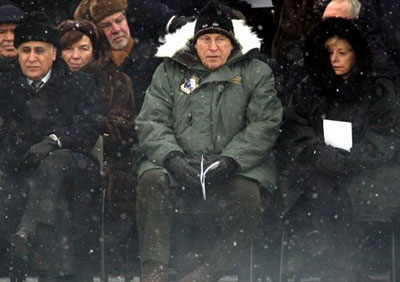
This is all over left bloggerville, but must be passed on. From Salon's War Room: "Washington Post fashion columnist Robin Givhan doesn't think much of Vice President Dick Cheney's choice of attire for Thursday's commemoration of the 60th anniversary of the liberation of Auschwitz. Cheney's dressing down in a parka and ski cap, Givhan notes, was rather at odds with the solemnity of the event." Givhan's text:
"The ceremony at the Nazi death camp was outdoors, so those in attendance, such as French President Jacques Chirac and Russian President Vladimir Putin, were wearing dark, formal overcoats and dress shoes or boots. Because it was cold and snowing, they were also wearing gentlemen's hats. In short, they were dressed for the inclement weather as well as the sobriety and dignity of the event.
"The vice president, however, was dressed in the kind of attire one typically wears to operate a snow blower.
"Cheney stood out in a sea of black-coated world leaders because he was wearing an olive drab parka with a fur-trimmed hood. It is embroidered with his name. It reminded one of the way in which children's clothes are inscribed with their names before they are sent away to camp. And indeed, the vice president looked like an awkward boy amid the well-dressed adults.
"Like other attendees, the vice president was wearing a hat. But it was not a fedora or a Stetson or a fur hat or any kind of hat that one might wear to a memorial service as the representative of one's country. Instead, it was a knit ski cap, embroidered with the words 'Staff 2001.' It was the kind of hat a conventioneer might find in a goodie bag.
"It is also worth mentioning that Cheney was wearing hiking boots -- thick, brown, lace-up ones. Did he think he was going to have to hike the 44 miles from Krakow -- where he had made remarks earlier in the day -- to Auschwitz?"
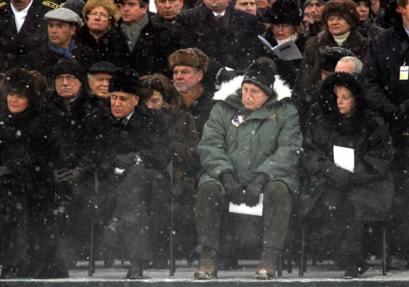
You could almost feel sorry for him if he wasn't responsible for so many people getting killed. There is some difference of opinion on whether this happened because he and Lynne came from separate events, and she wasn't around to help him dress, or if this is just him being indifferent to "Old Europe." Weighing in on the side of arrogance, I'm reminded of the story of Cheney on the campaign trail ordering a bunch of vegetables from a farmer and then just handing him a ten dollar bill, without asking for the price.
Details from Michael Bell-Smith's video, Top of the World, at Foxy Production, in the group exhibition "GEO," which runs through February 8, 2005.

The video begins with an aerial perspective looking down on a videogame landscape (sort of reminiscent of the old Intellivision tank battle terrain, but it could be a lot of things from that era). Directional arrows invade the middle ground and...
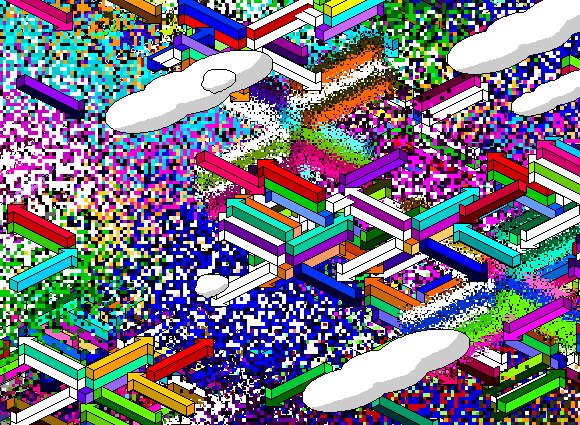
...after passing over, under, and around each other they begin to dissolve into painterly sprays of pure pixelation--a gorgeous effect, but not too gorgeous. It looks like a specific set of commands to "break down" as opposed to a one-click Photoshop filter; don't know if any, or how much, custom programming was required and don't care particularly. Eventually the screen fills with a succulent allover abstraction that could be Monet's Water Lilies a la Bit-Rot.
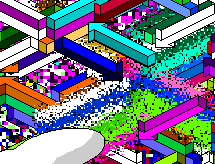
This detail showing the initial breakdown into pixels probably looks fuzzy in Safari--another browser is recommended to see this scaled up image super-sharp.
In the gallery, the video is displayed on an LCD screen directly from the computer. My only quibble is I miss seeing this type of imagery on the big clunky CRT picture tube, as a similar work of Bell-Smith's was displayed last summer in the Infinite Fill Group Show. Ideally when he has a solo exhibit we can see his work with a variety of formats and hardware. Also recommended is a music piece on Bell-Smith's blog that is a kind of marathon sequencer ditty--curious to see what happens with that if it reaches the projected 74 minutes.
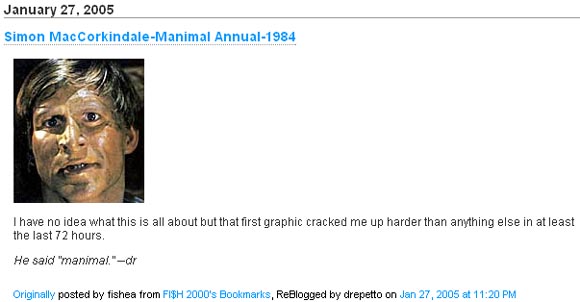
Still More Damn Metablogging
Just reading a New York Times article (linked to by Bill) that talks about how blogs are changing the design world because bloggers write from passion and editors and other trendspotters increasingly rely on them to suss out the new.* This hasn't happened in the art world, because galleries still don't know what blogs are. (Print magazines are figuring it out and thanks again to AinA.) One of the themes of the Rhizome "Blogging and the Arts" panel in Nov. at the New Museum was whether this thickheadedness on the part of art spaces was volitional. Most of the audience for that panel, I'd guess, came from the new media community, comprising folks making computer, internet, video, and multimedia art that is exciting and increasingly relevant as the world becomes more wired, but hard to commodify in the same way that galleries package and sell non-virtual artists.
Many in this cyber-community think the internet's openness and transparency threatens the gallery's traditional business of "creating the appearance of rarity or scarcity of objects in order to market them for high prices to an elite," as someone said that night. Yet at the same time the new media-ers ultimately want that gallery sanction--for the art world to say that what they do is not only art, but great art. My own response is there is no conspiracy, that the gallery world has certain habits of practice, which up till a few years ago included putting up shows, mailing out invitations, getting critics in, xeroxing the critics' clippings and mailing them to collectors, etc. but now includes dealing with the baffling and ever-changing world of websites and like it or not, blogs. Most overworked, underpaid gallery worker ants don't have the time, money, or energy to deal with this layer.
Having said all that, it's annoying that galleries don't acknowledge blog writing and still privilege King Print. I admit I only recently added blog references and hyperlinks to my personal resume, and it's going to be a pain to keep track of them as URLs change or heaven forbid disappear. But I think it's an important step. From the galleries' perspective, legitimation or verification of artists ought to be a two way street, or packet exchange or whatever: they rely on known critics to build the case for work, but they also endorse lesser-known critics by including them in their artists' clipping files. If an up-and-coming critic says something perceptive about a show that the mainstream media mavens missed, the gallery helps spread the word that that writer has a clue by listing their writing on the bio. Thus begins a cycle of mutual critical reinforcement, what the cynical might call a circle jerk, but nevertheless potentially scene-defining.
*The article goes on to talk about how manufacturers corrupt this process by giving bloggers freebies in exchange for plugs, but the art world isn't even to stage one of bloggers mattering yet.
